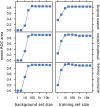MedlineRanker: flexible ranking of biomedical literature
- PMID: 19429696
- PMCID: PMC2703945
- DOI: 10.1093/nar/gkp353
MedlineRanker: flexible ranking of biomedical literature
Abstract
The biomedical literature is represented by millions of abstracts available in the Medline database. These abstracts can be queried with the PubMed interface, which provides a keyword-based Boolean search engine. This approach shows limitations in the retrieval of abstracts related to very specific topics, as it is difficult for a non-expert user to find all of the most relevant keywords related to a biomedical topic. Additionally, when searching for more general topics, the same approach may return hundreds of unranked references. To address these issues, text mining tools have been developed to help scientists focus on relevant abstracts. We have implemented the MedlineRanker webserver, which allows a flexible ranking of Medline for a topic of interest without expert knowledge. Given some abstracts related to a topic, the program deduces automatically the most discriminative words in comparison to a random selection. These words are used to score other abstracts, including those from not yet annotated recent publications, which can be then ranked by relevance. We show that our tool can be highly accurate and that it is able to process millions of abstracts in a practical amount of time. MedlineRanker is free for use and is available at http://cbdm.mdc-berlin.de/tools/medlineranker.
Figures


Similar articles
-
G-Bean: an ontology-graph based web tool for biomedical literature retrieval.BMC Bioinformatics. 2014;15 Suppl 12(Suppl 12):S1. doi: 10.1186/1471-2105-15-S12-S1. Epub 2014 Nov 6. BMC Bioinformatics. 2014. PMID: 25474588 Free PMC article.
-
Alkemio: association of chemicals with biomedical topics by text and data mining.Nucleic Acids Res. 2014 Jul;42(Web Server issue):W422-9. doi: 10.1093/nar/gku432. Epub 2014 May 16. Nucleic Acids Res. 2014. PMID: 24838570 Free PMC article.
-
Ranking the whole MEDLINE database according to a large training set using text indexing.BMC Bioinformatics. 2005 Mar 24;6:75. doi: 10.1186/1471-2105-6-75. BMC Bioinformatics. 2005. PMID: 15790421 Free PMC article.
-
Searching the MEDLINE literature database through PubMed: a short guide.Onkologie. 2005 Oct;28(10):517-22. doi: 10.1159/000087186. Epub 2005 Aug 19. Onkologie. 2005. PMID: 16186693 Review.
-
Interactive text mining with Pipeline Pilot: a bibliographic web-based tool for PubMed.Infect Disord Drug Targets. 2009 Jun;9(3):366-74. doi: 10.2174/1871526510909030366. Infect Disord Drug Targets. 2009. PMID: 19519489 Review.
Cited by
-
On the Conformational Dynamics of β-Amyloid Forming Peptides: A Computational Perspective.Front Bioeng Biotechnol. 2020 Jun 3;8:532. doi: 10.3389/fbioe.2020.00532. eCollection 2020. Front Bioeng Biotechnol. 2020. PMID: 32656188 Free PMC article. Review.
-
Caipirini: using gene sets to rank literature.BioData Min. 2012 Feb 1;5(1):1. doi: 10.1186/1756-0381-5-1. BioData Min. 2012. PMID: 22297131 Free PMC article.
-
PESCADOR, a web-based tool to assist text-mining of biointeractions extracted from PubMed queries.BMC Bioinformatics. 2011 Nov 9;12:435. doi: 10.1186/1471-2105-12-435. BMC Bioinformatics. 2011. PMID: 22070195 Free PMC article.
-
A practical application of text mining to literature on cognitive rehabilitation and enhancement through neurostimulation.Front Syst Neurosci. 2014 Sep 26;8:182. doi: 10.3389/fnsys.2014.00182. eCollection 2014. Front Syst Neurosci. 2014. PMID: 25309356 Free PMC article. Review.
-
A Deep Learning Approach to Refine the Identification of High-Quality Clinical Research Articles From the Biomedical Literature: Protocol for Algorithm Development and Validation.JMIR Res Protoc. 2021 Nov 29;10(11):e29398. doi: 10.2196/29398. JMIR Res Protoc. 2021. PMID: 34847061 Free PMC article.
References
-
- Perez-Iratxeta C, Bork P, Andrade MA. XplorMed: a tool for exploring MEDLINE abstracts. Trends Biochem. Sci. 2001;26:573–575. - PubMed
-
- Yamamoto Y, Takagi T. Biomedical knowledge navigation by literature clustering. J. Biomed. Inform. 2007;40:114–130. - PubMed
-
- Rebholz-Schuhmann D, Kirsch H, Arregui M, Gaudan S, Rynbeek M, Stoehr P. Protein annotation by EBIMed. Nat. Biotechnol. 2006;24:902–903. - PubMed
Publication types
MeSH terms
LinkOut - more resources
Full Text Sources
Molecular Biology Databases

